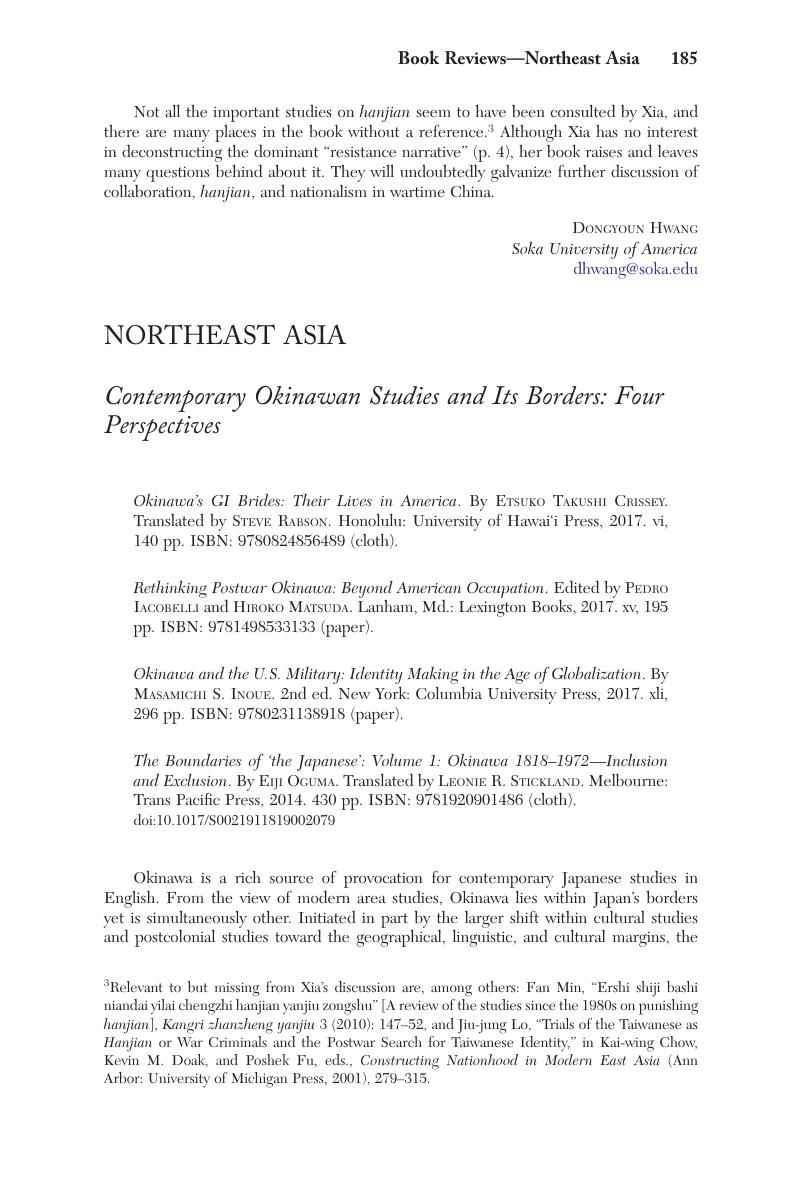Article contents
Contemporary Okinawan Studies and Its Borders: Four Perspectives - Okinawa's GI Brides: Their Lives in America. By Etsuko Takushi Crissey. Translated by Steve Rabson. Honolulu: University of Hawai‘i Press, 2017. vi, 140 pp. ISBN: 9780824856489 (cloth). - Rethinking Postwar Okinawa: Beyond American Occupation. Edited by Pedro Iacobelli and Hiroko Matsuda. Lanham, Md.: Lexington Books, 2017. xv, 195 pp. ISBN: 9781498533133 (paper). - Okinawa and the U.S. Military: Identity Making in the Age of Globalization. By Masamichi S. Inoue. 2nd ed.New York: Columbia University Press, 2017. xli, 296 pp. ISBN: 9780231138918 (paper). - The Boundaries of ‘the Japanese’: Volume 1: Okinawa 1818–1972—Inclusion and Exclusion. By Eiji Oguma. Translated by Leonie R. Stickland. Melbourne: Trans Pacific Press, 2014. 430 pp. ISBN: 9781920901486 (cloth).
Review products
Published online by Cambridge University Press: 24 February 2020
Abstract

- Type
- Book Reviews—Northeast Asia
- Information
- Copyright
- Copyright © The Association for Asian Studies, Inc. 2020
References
1 Treat, John Whittier, “Japan Is Interesting: Modern Japanese Literary Studies Today,” Japan Forum 30, no. 3 (2018): 421–40CrossRefGoogle Scholar.
2 Molasky, Michael S. and Rabson, Steve, eds., Southern Exposure: Modern Japanese Literature from Okinawa (Honolulu: University of Hawai‘i Press, 2000)Google Scholar.
3 Kina, Ikue, “Locating Tami Sakiyama's Literary Voice in Globalizing Okinawan Literature,” International Journal of Okinawan Studies 2, no. 2 (2011), 11–29, 19Google Scholar.
4 In Okinawa and the U.S. Military, reviewed in this essay, Masamichi Inoue puts the number of civilian casualties as high as 150,000 (Inoue, p. 38).
5 As one example of misgivings about the term “reversion,” given the circumstances under which Okinawa Prefecture came into existence, Arakawa Akira favors the term “re-annexation.” Akira, Arakawa, “Confronting Home-Grown Contradictions: Reflections on Okinawa's ‘Forty Years Since Reversion,’” Asia-Pacific Journal: Japan Focus 11, no. 25(1) (2013)Google Scholar.
6 Lo, Jacqueline, “Beyond Happy Hybridity: Performing Asian Australian Identities,” in Ang, Ien, Chalmers, Sharon, Law, Lisa, and Thomas, Mandy, eds., Alter/Asians: Asian-Australian Identities in Art, Media and Popular Culture (Sydney: Pluto Press, 2000), 152–68Google Scholar.
7 Angst, Linda Isako, “The Rape of a Schoolgirl: Discourses of Power and Gendered National Identity in Okinawa,” in Hein, Laura Elizabeth and Selden, Mark, eds., Islands of Discontent: Okinawan Responses to Japanese and American Power (Lanham, Md.: Rowman & Littlefield, 2003), 135–57Google Scholar.
8 Keyso, Ruth Ann, Women of Okinawa: Nine Voices from a Garrison Island (Ithaca, N.Y.: Cornell University Press, 2000)Google Scholar; Koikari, Mire, Cold War Encounters in US-Occupied Okinawa: Women, Militarized Domesticity and Transnationalism in East Asia (Cambridge: Cambridge University Press, 2015)CrossRefGoogle Scholar.
9 Kerr, George H., Okinawa: The History of an Island People (Rutland, Vt.: Tuttle, 1958)Google Scholar.
10 Ishikawa, Mao, Red Flower: The Women of Okinawa, trans. Sato, Jun (New York: Session Press, 2017)Google Scholar.
11 Shimabuku, Annmaria M., Alegal: Biopolitics and the Unintelligibility of Okinawan Life (New York: Fordham University Press, 2019)Google Scholar.
12 Isao, Nakazato, “Okinawa as an Intersection of Colonialisms: Toward Creating a Place Open to and Interconnecting with Asia,” International Critical Thought 3, no. 2 (2013): 183–97, 195–96CrossRefGoogle Scholar.
- 1
- Cited by




